
As many of QE’s Vex robotics teams pit themselves against the best on the planet this term at the world championships in Dallas, the senior boys in the VRC competition are celebrating strong performances at their national finals.
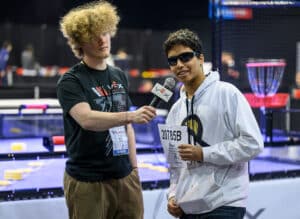 This year, QE sent six teams to the VRC National Championships at Telford International Centre for the first time. With six junior teams also making the journey, Queen Elizabeth’s School had more teams at the national finals than any other organisation.
This year, QE sent six teams to the VRC National Championships at Telford International Centre for the first time. With six junior teams also making the journey, Queen Elizabeth’s School had more teams at the national finals than any other organisation.
Head of Technology Michael Noonan said the senior teams headed for Telford with the feeling that a national championship might be on the cards for the first time since 2020 – and so it proved! After the tough final stages, Year 10’s Team Nova duly took the crown.
“Our Nova team did tremendously well. They started very strongly out of the blocks, then slipped down the rankings on day two, before coming back strongly and mustering a great performance in the final to clinch the title,” said Mr Noonan. “My congratulations also go to our other senior performers, who include those in Year 12 who did well, but are unable to go to the world championships because of this term’s public examinations.”
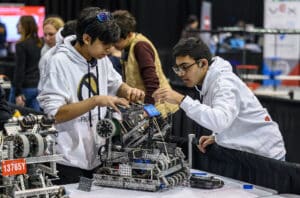 The QE boys benefitted from the support of corporate sponsor, Kingston Technology, sporting QE hoodies bearing the Kingston logo.
The QE boys benefitted from the support of corporate sponsor, Kingston Technology, sporting QE hoodies bearing the Kingston logo.
Nova competed along with three other Year 10 teams – Typhoon, Oblivion and Shattersquad – and two Year 12 teams, Hybrid and Tempest.
The teams were split evenly between the Lovelace and Brunel divisions in the competition at Telford. While the older teams struggled a little, not least because of problems caused by some last-minute adjustments, Nova and Typhoon began well.
On day two, some high-scoring losses sent Nova and Hybrid down the rankings, but Nova, together with Team Tempest, managed to consolidate their positions in the Skills challenge, with the former finishing second and Team Tempest climbing to fifth.
At the conclusion of the divisional group stages, Team Nova were fourth in the Brunel division. QE’s best performance in the Lovelace division came from Typhoon, who were fifth.
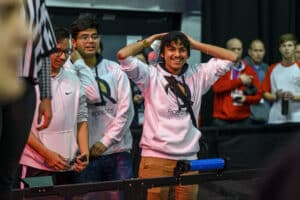 As the final stages progressed, high-performing QE sides found themselves facing each other, with Typhoon defeating Shattersquad in a Lovelace quarter-final and Nova beating Hybrid in a Brunel semi-final.
As the final stages progressed, high-performing QE sides found themselves facing each other, with Typhoon defeating Shattersquad in a Lovelace quarter-final and Nova beating Hybrid in a Brunel semi-final.
“This paved the way for teams from QE to participate in both divisional finals, and the real possibility of an all-QE national final between the winners in each division,” said Mr Noonan.
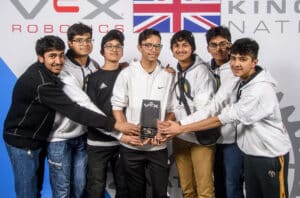 It was not to be, however. After a complicated series of events started when illegal parts were spotted on another team’s robot, Typhoon had to battle against the disadvantage of having to disable part of their own robot. They fought bravely alongside their alliance partner, but in the end, lost their deciding game by a single point, 133-134. “Divisional runners up, their pride was still intact and they learned a great deal from this experience,” said Mr Noonan.
It was not to be, however. After a complicated series of events started when illegal parts were spotted on another team’s robot, Typhoon had to battle against the disadvantage of having to disable part of their own robot. They fought bravely alongside their alliance partner, but in the end, lost their deciding game by a single point, 133-134. “Divisional runners up, their pride was still intact and they learned a great deal from this experience,” said Mr Noonan.
Nova and their alliance partner had a tough final, but having won their first match 153-143, they went on to a final score of 195-143 to secure the much-coveted national championship. Nova also took a Build award and Hybrid a Design award.

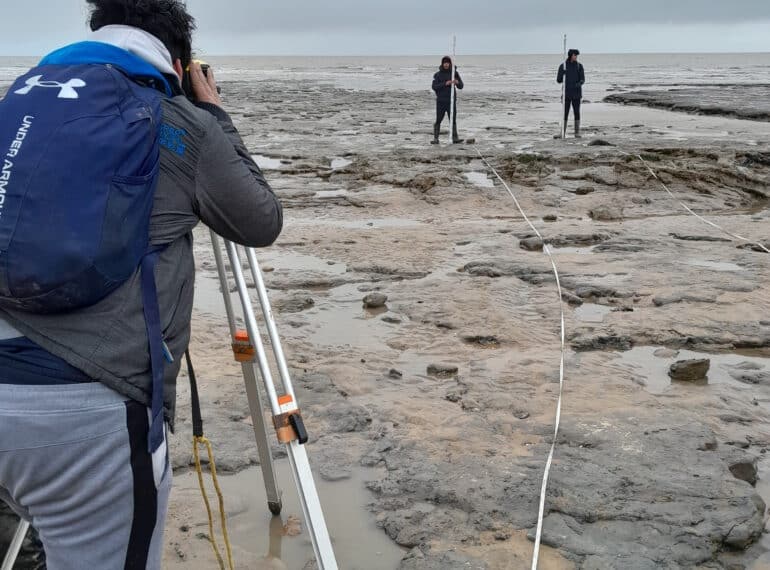
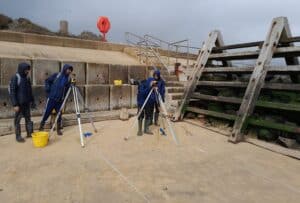 Braving a biting chill on the beach, the Sixth Form group investigated not only the threat posed by rapid coastal erosion at Walton-on-the-Naze, but also evaluated steps being taken by the town’s authorities to check it.
Braving a biting chill on the beach, the Sixth Form group investigated not only the threat posed by rapid coastal erosion at Walton-on-the-Naze, but also evaluated steps being taken by the town’s authorities to check it.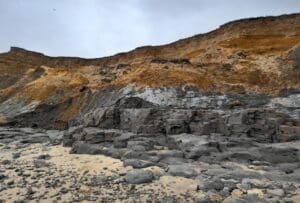 Walton has one of the fastest retreating cliff lines in the British Isles: on average, the cliffs are retreating between one and two metres every year. That the cliffs are falling away so rapidly is due largely to their geology.
Walton has one of the fastest retreating cliff lines in the British Isles: on average, the cliffs are retreating between one and two metres every year. That the cliffs are falling away so rapidly is due largely to their geology. “However, the formations unfortunately represent a relatively weak barrier to coastal erosion.”
“However, the formations unfortunately represent a relatively weak barrier to coastal erosion.”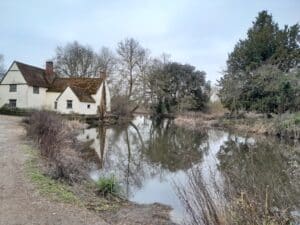 “Although no fossils were recovered, the fieldtrip was a great success, and despite the weather being bitterly cold, the boys demonstrated admirable fieldwork skills in sampling and collecting their data before analysis back in the classroom,” said Mr Butler.
“Although no fossils were recovered, the fieldtrip was a great success, and despite the weather being bitterly cold, the boys demonstrated admirable fieldwork skills in sampling and collecting their data before analysis back in the classroom,” said Mr Butler.
 The boys were special guests at one of AWS’s monthly re:Purpose days, on which AWS staff are encouraged to get involved in projects and initiatives outside of their normal day-to-day work.
The boys were special guests at one of AWS’s monthly re:Purpose days, on which AWS staff are encouraged to get involved in projects and initiatives outside of their normal day-to-day work. Enterprise Business Development Representative, Ella Cooper, who organised the day, together with her colleague, Juste Mena, said the day had seen the QE visitors “diving deep into careers in the cloud”.
Enterprise Business Development Representative, Ella Cooper, who organised the day, together with her colleague, Juste Mena, said the day had seen the QE visitors “diving deep into careers in the cloud”. They also heard from Senior Manager Joe Welton and Solutions Architect, Jack Bark.
They also heard from Senior Manager Joe Welton and Solutions Architect, Jack Bark.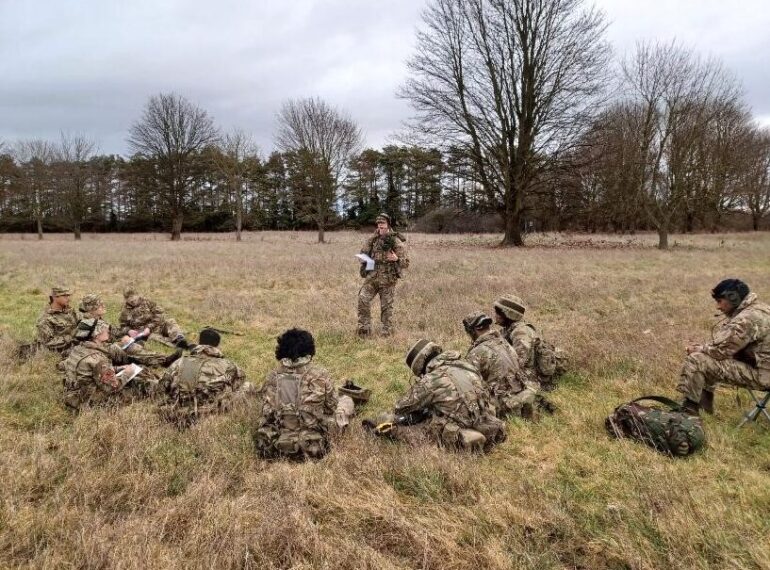
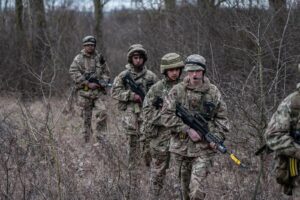 The School is planning a series of exercises so that QE’s Combined Cadet Force can try their hand against the local ACF.
The School is planning a series of exercises so that QE’s Combined Cadet Force can try their hand against the local ACF.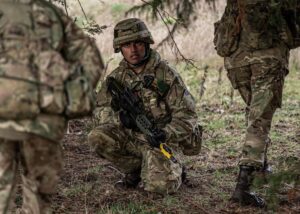 The half-term camp involving ten Sixth Form CCF cadets took place at the Cadet Training Centre Bassingbourn Barracks, Royston, north Hertfordshire.
The half-term camp involving ten Sixth Form CCF cadets took place at the Cadet Training Centre Bassingbourn Barracks, Royston, north Hertfordshire. It is essentially a screen that plays out like a video game, yet allows users to try real weapons with the correct action, recoil, and so on. The trainer reacts to the user’s decisions and execution, thus demonstrating the impact of his actions.
It is essentially a screen that plays out like a video game, yet allows users to try real weapons with the correct action, recoil, and so on. The trainer reacts to the user’s decisions and execution, thus demonstrating the impact of his actions.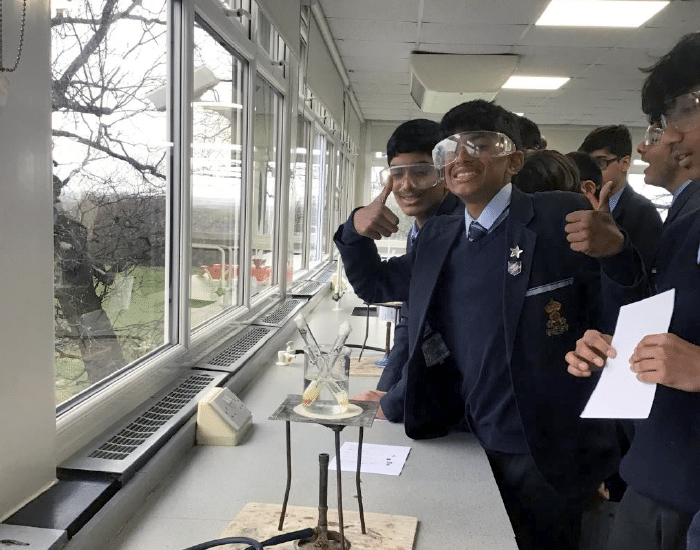
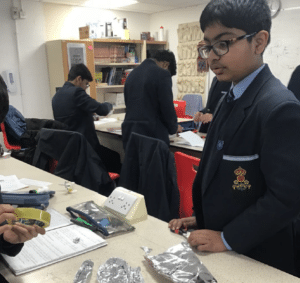 Year 8 boys conducted experiments to explore improvements in shipbuilding during Elizabeth I’s reign, to show how food was preserved in an age before refrigeration and to make their own Tudor-style soap.
Year 8 boys conducted experiments to explore improvements in shipbuilding during Elizabeth I’s reign, to show how food was preserved in an age before refrigeration and to make their own Tudor-style soap.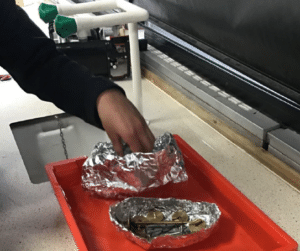 Another hands-on session involved making model boats out of aluminium foil to see which boat shape could hold the most mass. The boys learned that innovations by shipwrights during Elizabeth I’s reign allowed the introduction of ships that were faster, more manoeuvrable and carried heavier guns. The superiority of English ships was an important factor of the defeat of the Spanish Armada invasion fleet in 1588.
Another hands-on session involved making model boats out of aluminium foil to see which boat shape could hold the most mass. The boys learned that innovations by shipwrights during Elizabeth I’s reign allowed the introduction of ships that were faster, more manoeuvrable and carried heavier guns. The superiority of English ships was an important factor of the defeat of the Spanish Armada invasion fleet in 1588.